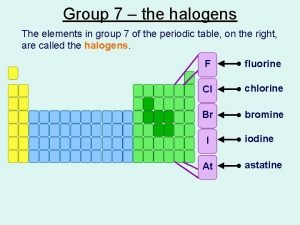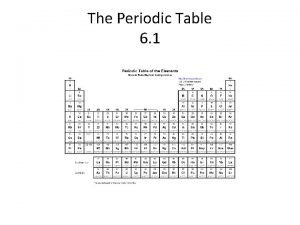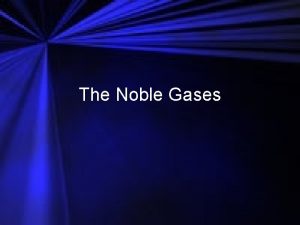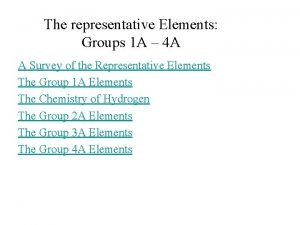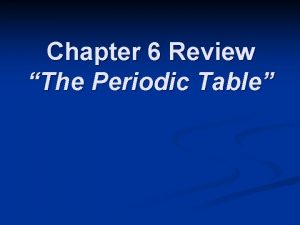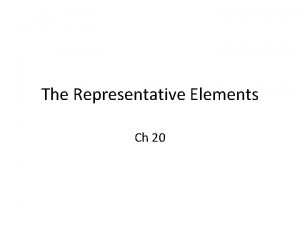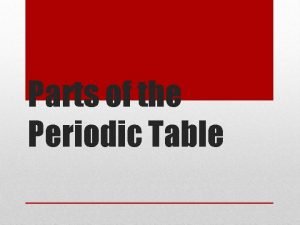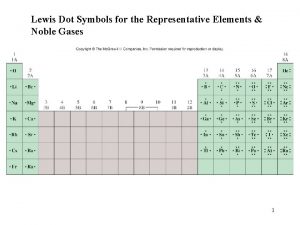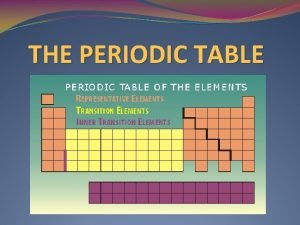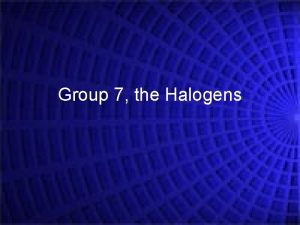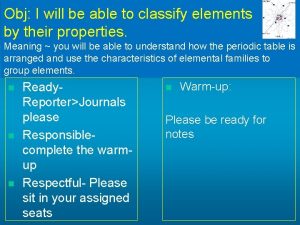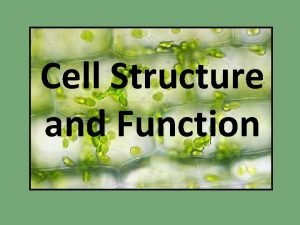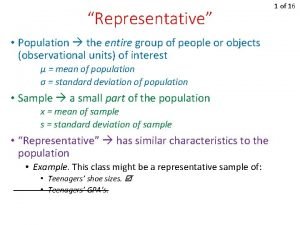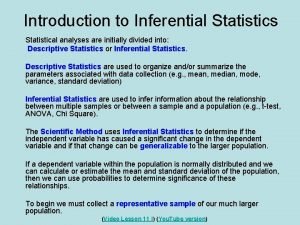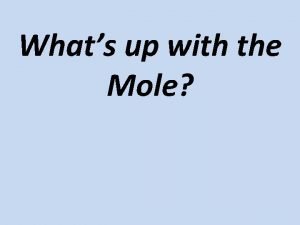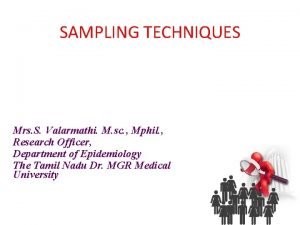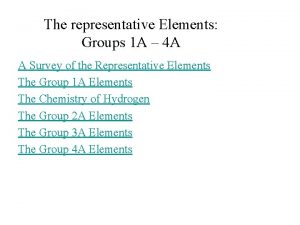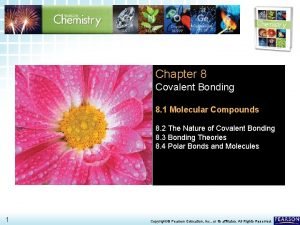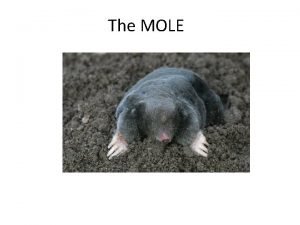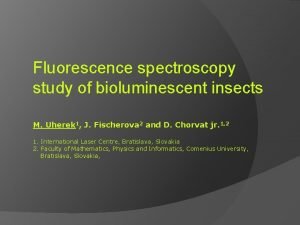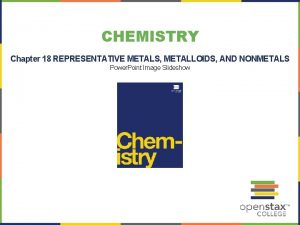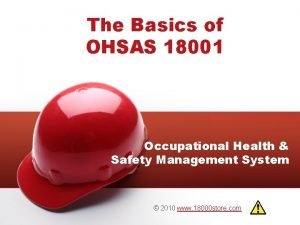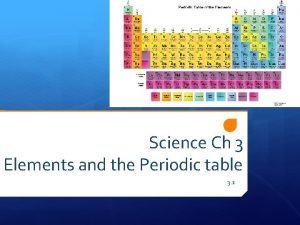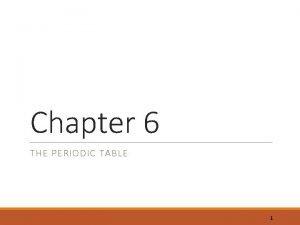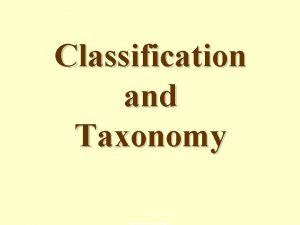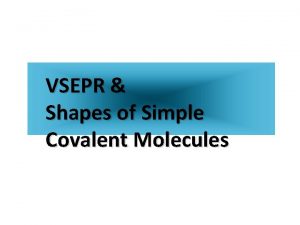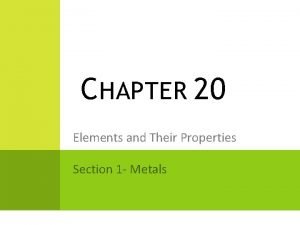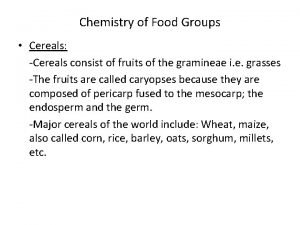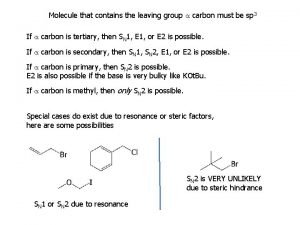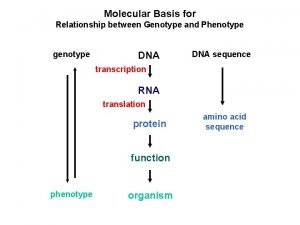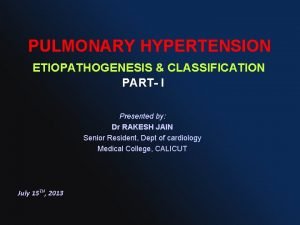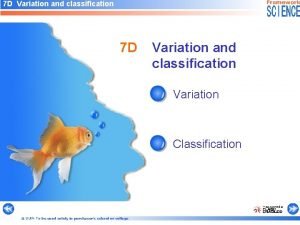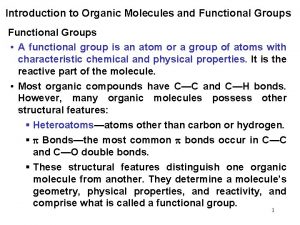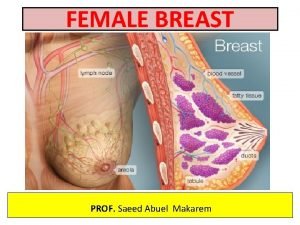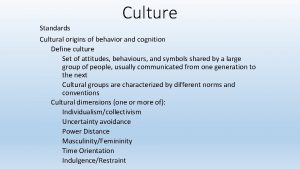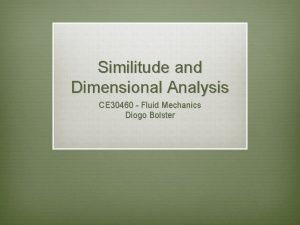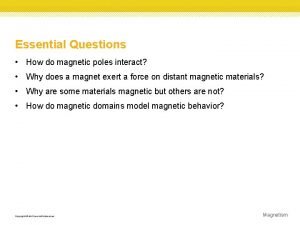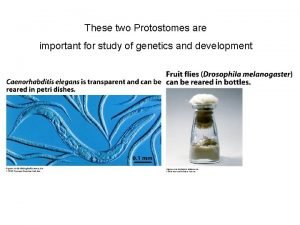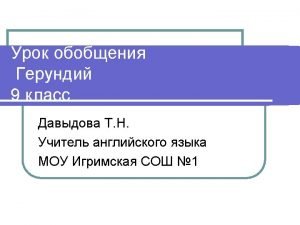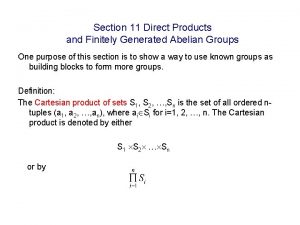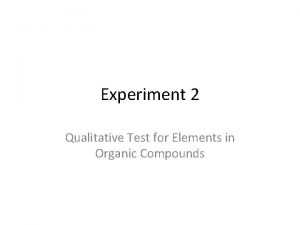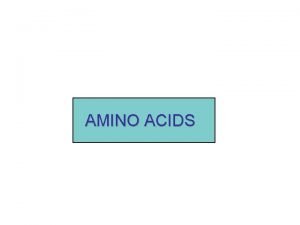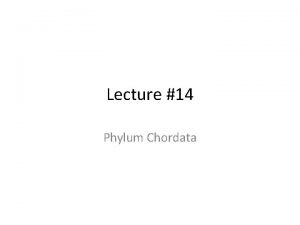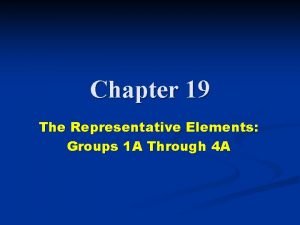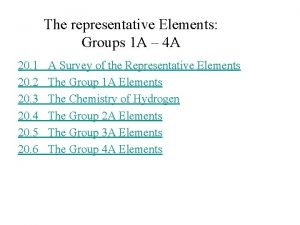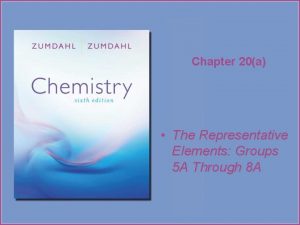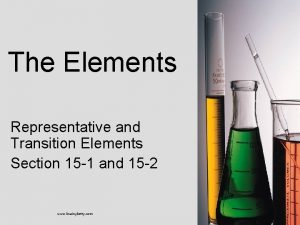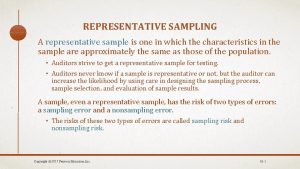The representative Elements Groups 1 A 4 A



































































































































































- Slides: 163

The representative Elements: Groups 1 A – 4 A A Survey of the Representative Elements The Group 1 A Elements The Chemistry of Hydrogen The Group 2 A Elements The Group 3 A Elements The Group 4 A Elements

The representative Elements: Groups 5 A – 8 A The Group 5 A Elements Chemistry of Nitrogen Chemistry of Phosphorus The Group 6 A Elements Chemistry of Oxygen Chemistry of Sulfur The Group 7 A Elements The Group 8 A Elements

Representative Elements • The location of the representative metals is shown in the periodic table. Nonmetals are shown in green, metalloids in purple, and the transition metals and inner transition metals in yellow.

A Review of the Periodic Table • Representative elements: § Groups 1 A – 8 A (Groups 1, 2, 13 -18) § The s and p blocks (subshells ns and np are filled) • Transition elements: § Groups 3 B – 2 B (Groups 3 – 12) § The d block (orbitals d are filled)

A Review of the Periodic Table • Lanthanides and Actinides: § Listed separately at bottom of the table § The f block (orbitals 4 f and 5 f are filled) • Metalloids: § Separate metals from nonmetals § B, Si, Ge, As, Sb, Te, Po, & At

The Trends of Nuclear Charge and Atomic Size • Effective nuclear charge: increases left-to-right and decreases top-to-bottom; • Atomic size: decreases left-to-right and increases top-to-bottom;

Atomic Radii of Some Representative Elements (in Picometers)

Trends in Ionization Energy • • Ionization energy (Ip): M(g) → M+(g) + e. Ionization energy increases left-to-right and decreases top-to-bottom. 1. 2. 3. 4. Li > Na > K > Rb > Cs; F > Cl > Br > I; C < O < N < F; (anomaly between N & O) Li < Be < C; (anomaly between Be & B)

Electron Affinity = the energy that is released when an electron is added to a gaseous atom + Energy

Trends in Electron Affinity • Electron afffinity (EA) = energy released when an electron is added to gaseous atom; • Electron affinity increases from left to right and decreases from top to bottom: C < N < O < F; I < Br < F < Cl (anomaly between Cl and F. Why? )

Trends in Electronegativity • Electronegativity = the relative ability to compete for electrons; In molecules, bonding electrons are drawn closer to the more electronegative atom. • Electronegativity increases from left to right and decreases top to bottom: C < N < O < F; I < Br < Cl < F;

Chemical Reactivity • Reactivity of metals decreases left-to-right and increases top-to-bottom. Na > Mg > Al; Li < Na < K; • Reactivity of nonmetals increases left-to-right and decreases top-to-bottom. N < O < F; F > Cl > Br;

Concept Check Which atom is larger, Na or Cl? Why? Na Cl

Concept Check Which atom is larger, Li or Cs? Why? Li Cs

Concept Check Which is more reactive and why? (a) Li or Cs? (b) Na or Al? (c) F or I? (d) P or Cl?

Distribution of 18 Most Abundant Elements

Abundance of Elements in the Human Body

Alkali Metals: Sources and Methods of Preparation

Group 1 A Oxides • Reactions of alkali metals with oxygen gas do not produce the same oxides: 4 Li(s) + O 2(g) 2 Li 2 O(g) (simple oxide) 2 Na(s) + O 2(g) Na 2 O 2(s) (peroxide) K(s) + O 2(g) KO 2(s) (superoxide)

Production of Alkali Metals • Li, Na and K are produced by electrolysis of molten chlorides (Li. Cl, Na. Cl and KCl). • K is also produced by displace method using molten KCl and sodium vapor: KCl(l) + Na(g) K(g) + Na. Cl(l)

Production of Sodium by Electrolysis of Molten Na. Cl • Pure sodium metal is isolated by electrolysis of molten sodium chloride using a Downs cell. It is not possible to isolate sodium by electrolysis of aqueous Na. Cl solutions, because hydrogen ions are more easily reduced than are sodium ions; as a result, hydrogen gas forms at the cathode instead of the desired sodium metal. The high temperature required to melt Na. Cl means that liquid sodium metal forms.

Important Reactions of Alkali Metals • • • 4 Li(s) + O 2(g) 2 Li 2 O(s) 2 Na(s) + O 2(g) Na 2 O 2(s) K(s) + O 2(g) KO 2(s) 6 M(s) + N 2(g) 2 M 3 N(s) 2 M(s) + H 2 O(l) MOH(aq) + H 2(g) 2 M(s) + X 2(g) 2 MX(s) (M = Li, Na, K, Rb, Cs; X = F, Cl, Br, I)

Exercise-#1 • Complete and balance each of the following equations: 1. Na(s) + H 2 O(l) ? 2. Li(s) + N 2(g) ? 3. KO 2(s) + CO 2(g) ?

Exercise-#2 Predict the products formed by the following reactants: Na 2 O 2(s) + H 2 O(l) → Na. OH(aq) + H 2 O 2(l)

Uses of Lithium and Lithium Compounds • Lithium mainly used to make lithium batteries; • Li. Cl is used in air-conditioning units as dehumidifier; • Li 2 CO 3 is used in porcelain enamel, manufacture of strong (pyrex) glasses, and as medication for manic depression;

Important Compounds of Sodium • Na. Cl: 1. As an ingredient in food – Na+ is essential for electrolyte balance; 2. Production of sodium metal by electrolysis of molten Na. Cl; 2 Na. Cl(l) 2 Na(s) + Cl 2(g) 3. Production of Na. OH by electrolysis of aqueous Na. Cl; 2 Na. Cl(aq) 2 Na. OH(aq) + H 2(g) + Cl 2(g)

Important Compounds of Sodium Na. HCO 3 – baking soda: used for making cookies and cakes, and in fire-extinguishers Na 2 CO 3 – used in manufacture of ground glasses and as industrial bases; Na. OH – used in manufacture of bleach, as a strong base, and as drain cleaners; The manufacture of household bleach: Cl 2(g) + 2 Na. OH(aq) Na. OCl(aq) + Na. Cl(aq) + H 2 O(l)

Important Compounds of Potassium • K+ is essential for nervous system; • K 2 O is important component in fertilizers; • KO 2 is used in confined places like submarines for removal of CO 2 and production of O 2: 4 KO 2(s) + 2 CO 2(g) 2 K 2 CO 3(s) + 3 O 2(g)

Hydrogen • • Most abundant element in the universe, but makes up <1% (by mass) on Earth crust. Isotopes of hydrogen: 1. Hydrogen (1 H) - has no neutron; most abundant 2. Deuterium (2 H) - has one neutron 3. Tritium (3 H) – has 2 neutrons; radioactive (halflife ~ 12. 3 yrs)

Isotope Effects • Deuterium exhibits significant isotope effects on chemical and physical properties. 1. Freezing points: H 2 O (0. 00 o. C); D 2 O (3. 81 o. C) 2. Boiling points: H 2 O (100. 0 o. C); D 2 O (101. 42 o. C) 3. Density at 25 o. C (g/m. L): H 2 O (0. 997); D 2 O (1. 104)

Hydrides • Binary compounds containing hydrogen: § Ionic hydrides: (hydrogen + reactive metals) Examples: Li. H, Ca. H 2 § Covalent hydrides: (hydrogen + other nonmetals) Examples: H 2 O, CH 4, NH 3) § Metallic (interstitial) hydrides: H 2 gas in certain transition metal crystals

Production of Hydrogen • Laboratory preparation of hydrogen gas: Mg(s) + 2 HCl(aq) Mg. Cl 2(aq) + H 2(g) Zn(s) + H 2 SO 4(aq) Zn. SO 4(aq) + H 2(g) • Industrial production method by steamreformation of hydrocarbon: CH 4(g) + H 2 O(g) CO(g) + 3 H 2(g); H = 205 k. J CO(g) + H 2 O(g) CO 2(g) + H 2(g); H = -41 k. J

Uses of Hydrogen 1. Production of Ammonia using the Haber process: N 2(g) + 3 H 2(g) 2 NH 3(g) 2. Production of Methanol: CO(g) + 2 H 2(g) CH 3 OH(l) 3. Hydrogenation of vegetable oil: Vegetable oil + H 2(g) “Crisco” and Margarine 4. Manufacture of hydrochloric acid H 2(g) + Cl 2(g) 2 HCl(g) HCl(aq)

Exercise-#3 Predict the products formed by the following reactants: Li. H(s) + H 2 O(l) → H 2(g) + Li. OH(aq)

Alkaline Earth Metals • • • Be, Mg, Ca, Sr, Ba, and Ra (radioactive); Very reactive elements; Valence-shell electron configuration: ns 2 Cations = M 2+, has noble gas configuration; Practical importance: § Ca 2+ and Mg 2+ are essential to life; § Mg is a component in light alloys

Occurrence and Preparation • Abundance in Earth’s crust: 1. Calcium and magnesium rank 5 th and 6 th, respectively. 2. Magnesium found in the ocean (~0. 055 M) and in Mg. CO 3 (dolomite) 3. Seawater important source of Mg; 4. Calcium found in limestone and sea shells (Ca. CO 3) – most abundant mineral on Earth 5. Mg and Ca are prepared by electrolysis of the molten Mg. Cl 2 and Ca. Cl 2, respectively.

Compounds of Alkaline Earth Metals • Except for Be, all oxides and halides of alkaline Earth metals are ionic compounds; • Beryllium forms covalent compounds; • Except for Be. O, all oxides of alkaline Earth metals are basic – forms strong basic solutions; • Be. O is amphoteric;

Extraction of Mg from Seawater

Electrolysis of Molten Mg. Cl 2

Extraction of Mg from Seawater 1. Mg 2+(aq) + Ca. O(s) + H 2 O(l) Mg(OH)2(s) + Ca 2+(aq) 2. Mg(OH)2(s) + 2 HCl(aq) Mg. Cl 2(aq) + 2 H 2 O(l) 3. Mg. Cl 2(aq) Mg. Cl 2(s) Mg. Cl 2(l) 4. Mg. Cl 2(l) electrolysis Mg(s) + Cl 2(g);

Extraction of Calcium from Ca. CO 3 • Ca. CO 3(s) + 2 HCl(aq) Ca. Cl 2(aq) + H 2 O(l) + CO 2(g); • Ca. Cl 2(aq) Ca. Cl 2(s) Ca. Cl 2(l); • Ca. Cl 2(l) electrolysis Ca(s) + Cl 2(g)

Uses of Some Alkaline Earth Metals • Beryllium: 1. a component in alloys for making tough springs and non-sparking tools 2. Used as X-ray tube window; 3. A neutron source in nuclear reactor;

Uses of Some Alkaline Earth Metals • Magnesium is used: 1. in the manufacture of light-weight alloys for aircraft body and parts; 2. as reducing agent in the extraction of silicon, titanium and beryllium; 3. in Grignard reagents for organic synthesis; 4. An ingredient in fireworks and warning flare; Calcium is also used as reducing agent in the extraction of other metals, such as Sc and W;

Important Compounds of Magnesium • Mg 2+ is essential to life; • Many enzymes require Mg 2+; Mg 2+ is an essential component of chlorophyll; • Mg. O is a component in ceramic and used in refractory furnace lining; • Mg(OH)2 is active component of antacid “Milk of Magnesia” • Mg. SO 4 found in fertilizers and food supplements

Important Compounds of Calcium • • • Like Mg 2+, Ca 2+ is essential to life; In cell physiology, movements of Ca 2+ in and out of cytoplasm function as signal for many cellular processes; Ca 5(PO 4)3(OH) - in teeth and bone structures; Ca. CO 3 – forms protective coverings, as in egg and sea shells; Ca. CO 3 (limestone) - most abundant mineral; 1. Pure Ca. CO 3 are used as fillers in paint, toothpaste, paper, plastics, etc. ; 2. the source for calcium metal and quicklime: Calcination: Ca. CO 3(s) Ca. O(s) + CO 2(g)

Important Compounds of Calcium • Ca. O – also called quicklime, uses: 1. important ingredient of Portland cement; 2. industrial base; 3. extraction of Mg from seawater; 4. in metallurgy – as base in steel production; 5. As scrubber to remove toxic gas SO 2 from industrial “flu-gas”: Ca. O(s) + SO 2(g) Ca. SO 3(s)

Ca 2+ & Mg 2+ in Water • Ca 2+ and Mg 2+ causes water hardness; Soaps do not form leather due to formation of precipitates with Ca 2+ & Mg 2+; • These ions can be removed by ion-exchange process. • Cation-exchange resins – large molecules that have many -SO 3 - sites, with Na+ as counter ions; • Ca 2+ and Mg 2+ bound more strongly to anionic sites and displace Na+.

A Schematic Representation of a Typical Cation Exchange Resin

Exercise-#4 • Complete and balance the following equations: 1. 2. 3. 4. Mg(s) + HCl(aq) ? Mg. H 2(s) + H 2 O(l) ? Ca(s) + H 2 O(aq) ? Ca. O(s) + SO 2(g) ?

Group 3 A • B, Al, Ga, In, and Tl; • Valence-shell electron configuration: ns 2 np 1 • Group 3 A elements show increasing metallic character going down the group. • Boron: a metalloid, forms covalent network solid, and highest melting point in the group

Some Physical Properties, Sources, and Methods of Preparation

Some Important Reactions

Properties of Boron (1 s 2 2 p 1) • A metalloid; forms covalent network solid; highest melting point in the group, and the least reactive • All boron compounds are covalent molecules; • Boron molecules, such as BF 3, have incomplete octet and acts as Lewis acid, example: BF 3 + : NH 3 F 3 B: NH 3 • Boron hydrides acquire octet by forming H-bridges; • Boron oxide, B 2 O 3, forms weak boric acid, B(OH)3;

Aluminum • Electron configuration: 1 s 2 2 p 6 3 s 2 3 p 1 or [Ar] 3 s 2 3 p 1 • Third most abundant element (and most abundant metal) in the Earth’s crust; • Most important metal of Group 3 A; • US annual production: over 5 millions tons;

Aluminum Production • Extracted from bauxite, Al 2 O 3 n. H 2 O; • Produced by the Hall-Heroult process - electrolysis of molten Al 2 O 3 -Na 3 Al. F 6 (cryolite) mixture at ~ 960 o. C • Aluminum production is an energy intensive process • Energy consumption: ~ 54 MJ/kg Al (~3% of electrical energy supply) • Re-cycling saves up to 95% of this energy; • (Re-cycle an aluminum can and power your desk-top monitor up to 3 hours)

Production of Aluminum

Production of Aluminum • An electrolytic cell is used for the production of aluminum. A molten mixture of cryolite, bauxite and calcium fluoride is electrolyzed, which produces aluminum metal at the cathode, and oxygen, carbon monoxide, and carbon dioxide at the anode.

Importance of Aluminum • Lightweight metal (density = 2. 70 g/cm 3); • Forms strong, lightweight alloys with copper and magnesium for aircraft bodies and parts; • High resistance to corrosion - extensively used to make beverage containers (soda drinks cans); • Also used as reducing agent in the fuel during space shuttle launching.

Chemical Properties of Aluminum • Reactive metal, readily oxidized by atmospheric O 2 to form Al 2 O 3; • Al 2 O 3 forms protective coating (an anodic protection) that prevents further corrosion of the metal; • Al 2 O 3 is amphoteric - reacts with both strong acids & bases; • Aluminum reacts with halogens to form Al. X 3; • Al 2 O 3 and Al. F 3 are strictly ionic compounds; • Other halides are ionic with covalent characteristics.

Reactions of Aluminum With strong acids: • 2 Al(s) + 6 HCl(aq) 2 Al. Cl 3(aq) + 3 H 2(g); • 2 Al(s) + 3 H 2 SO 4(aq) Al 2(SO 4)3(aq) + 3 H 2(g); • 2 Al(s) + 2 HNO 3(aq) Al 2 O 3(s) + 2 NO(g) + H 2 O(l) (The third reaction does not occur completely because the oxide forms protective coating to prevent further reaction. ) With a strong base: • 2 Al(s) + 6 H 2 O(l) + 2 Na. OH(aq) 2 Na. Al(OH)4(aq) + 3 H 2(aq);

Aluminum Halides

Important Compounds of Aluminum • Al 2 O 3 – source of aluminum metal and forms protective coating to the metal to prevent corrosion; • Al 2(SO 4)3 – most important industrial compound; 1. use in municipal water treatment plants; 2. Prepared by reaction of H 2 SO 4 with Al 2 O 3 or Al(OH)3: Al 2 O 3(s) + 3 H 2 SO 4(aq) Al 2(SO 4)3(s) + 3 H 2 O(l) 2 Al(OH)3(s) + 3 H 2 SO 4(aq) Al 2(SO 4)3(s) + 6 H 2 O(l)

Exercise-#5 1. Classify the following oxides as acidic, basic or amphoteric. B 2 O 3 • Al 2 O 3 In 2 O 3 Balance the following equations: 1. B(s) + HNO 3(aq) B 2 O 3(s) + NO(g) + H 2 O 2. Al(s) + H 2 SO 4(aq) Al 2(SO 4)3(aq) + H 2(g) 3. Al 2 O 3(s) + HCl(aq) Al. Cl 3(aq) + H 2 O(l)

Group 4 A (vsec: ns 2 np 2) • Contains: a nonmetal (C), two metalloids (Si & Ge), and two metals (Sn & Pb); • Carbon exists in 3 allotropic forms: graphite, diamond, and the “bucky-ball”. • Graphite has sp 2 hybridization; • Graphite is soft and conduct electric current; • Diamond contains sp 3 hybridization and forms covalent network solids; does not conduct electricity; • Diamond is the hardest material on Earth.

Some Physical Properties, Sources, and Methods of Preparation

Some Important Reactions

Group 4 A • Contains two most important elements on earth: carbon and silicon. • Both form four covalent bonds to nonmetals. § CH 4 and Si. F 4

Group 4 A (14): Carbon and Silicon

Carbon: 1 s 2 2 p 2 • Most important element on Earth – forms the basic skeletal structures of all living things; • Carbon forms strong covalent bonds with many elements and with itself; • Carbon forms sp, sp 2, and sp 3 hybridizations; • In sp hybridization, each carbon forms 2 s- and 2 pbonds; example in H―C≡C―H • In sp 2, each carbon forms 3 s- and a p- bonds; • In sp 3 hybridization each carbon forms 4 s-bonds;

Carbon Prentice-Hall © 2002 General Chemistry: Chapter 23 Slide 70 of 51

Carbon Prentice-Hall © 2002 General Chemistry: Chapter 23 Slide 71 of 51

Important Compounds of Carbon • CO – toxic gas (binds to hemoglobin); forms during combustion of carbon in limited oxygen supply; used in methanol production. • CO 2 – end-product of combustion of carbon or carbon -containing compounds; greenhouse gas that keeps Earth temperature relatively warm; • CO 2 is essential to life – used by plants in photosynthesis; • Na. HCO 3 – used as baking soda for cooking and as in fire-extinguishers; • Na 2 CO 3 – used in glass manufacture; • Ca. CO 3 – used in steel production;

Inorganic Compounds of Carbon • Ca. C 2 – Reaction with H 2 O produces acetylene. – miner’s lamps. • CS 2 – Flammable, volatile, poisonous. – Important solvent. • CCl 4 – Known carcinogen.

Exercise-#6 • Draw Lewis structures for the following ions and molecule and propose hybridization on the carbon atom in each ion or molecule. 1. 2. 3. 4. 5. CO 2 CO 32 HCO 3 H 2 CO 3 CF 4

Other Important Compounds of Carbon • CH 4 – major component of natural gas; used as fuel and for the production of hydrogen gas; • C 3 H 8 and C 4 H 10 – used as fuel; • C 6 H 14, C 7 H 16, C 8 H 18, and C 9 H 20 are components in gasoline, with C 8 H 18 as the major component; • C 6 H 12, (cyclohexane), C 6 H 14 (hexane), and C 6 H 6 (benzene) are important organic solvents; • C 2 H 4, C 2 H 3 Cl, C 2 F 4, and H 2 NCH 2 CH 2 CH 2 NH 2 (among others) are important monomers for polymers, such as polyethylene, PVC, Teflon, nylon, and polyester.

Chemistry of Silicon • Silicon - a metalloid; a covalent network solid with diamond-like structure; used as semi-conductors in the electronic equipment. • Silicon dioxide or silica (Si. O 2) - the second most abundant substance on the Earth’s crust; also the source of silicon; • Si. O 2 - used in the manufacture of glass and ceramics; • Silicon carbide (Si. C) has diamond-like structure; used to make abrasive and heat resistant ceramics.

Production and Use of Si • Reduce quartz or sand with C in a furnace. • Oxides of Si, only one is stable, Si. O 2. silicate silica mica

Production of Silicon • • Si. O 2(s) + 2 C(s) Si(s) + 2 CO(g); Si(s) + 2 Cl 2(g) Si. Cl 4(g); Si. Cl 4(g) + 2 Mg(s) Si(s) + 2 Mg. Cl 2(s); Final purification done by “zone-refining”

Purification of Silicon by Zone-refining

Silanes and Silicones

Tin and Lead • • • Both are soft metals; Tm(o. C): Sn (232) & Pb (327) Both metals form +2 and +4 oxidation states; Reacts with O 2 Sn. O, Sn. O 2, Pb. O & Pb. O 2; Reacts with Cl 2 Sn. Cl 2, Sn. Cl 4, Pb. Cl 2 & Pb. Cl 4; Sn. O, Pb. O, Sn. Cl 2, and Pb. Cl 2 are ionic; Sn. O 2, Pb. O 2, Sn. Cl 4, and Pb. Cl 4 are molecular;

Tin and Lead Ores and Uses • Cassiterite ore, Sn. O 2, reduced with C to Sn. • Galena, Pb. S, roasted in air then reduced with C. • Alloys of Sn – Solders – Bronze (90% Cu, 10% Sn – Pewter (85% Sn, 7% Cu, 6% Bi, 2% Sb) • Pb – Pimary use in storage batteries. – Radiation shields.

Important Compounds of Tin and Lead • • • Sn. Cl 2 – used as reducing agent, tin plating, catalyst; Sn. F 2 – additive in toothpaste to prevent cavity; Pb. O – used in ceramic glaze, and cement; Pb. O 2 – oxidizing agent and battery electrodes; Pb. Cr. O 4 – for making yellow pigment for paint;

Group 5 A • • Valence-shell configuration: ns 2 np 3 Exhibits varied chemical properties. 1. N and P are nonmetals; 2. As and Sb are metalloids; 3. Bi is a metal (the heaviest non-radioactive element)

The Nitrogen Family • Rich chemistry that can only be touched on here. – Nitrogen can exist in many oxidation states. • N and P are nonmetallic. • As and Sb are metalloid. • Bi is metallic.

Some Physical Properties, Sources, and Methods of Preparation


Oxides of Group 5 A Elements • • • Nitrogen: N 2 O, N 2 O 3, NO 2, N 2 O 4, N 2 O 5; Phosphorus: P 4 O 6 & P 4 O 10; Arsenic: As 2 O 3 (As 4 O 6) & As 2 O 5; Antimony: Sb 2 O 3 & Sb 2 O 5 Bismuth: Bi 2 O 3 & Bi 2 O 5

Oxidation States of N

Chlorides of Group 5 A Elements • • • Nitrogen: only NCl 3; Phosphorus: PCl 3 and PCl 5; Arsenic: As. Cl 3 and As. Cl 5; Antimony: Sb. Cl 3 and Sb. Cl 5; Bismuth: Bi. Cl 3 All are molecular compounds.

Reactions of Oxides and Chlorides • • 3 NO 2(g) + H 2 O(l) 2 HNO 3(aq) + NO(g); N 2 O 5(g) + H 2 O(l) 2 HNO 3(aq) P 4 O 10(s) + 6 H 2 O(l) 4 H 3 PO 4(aq); As 2 O 5(s) + 3 H 2 O(l) 2 H 3 As. O 4(aq); • PCl 5(s) + 4 H 2 O(l) H 3 PO 4(aq) + 5 HCl(aq); • As. Cl 5(s) + 4 H 2 O(l) H 3 As. O 4(aq) + 5 HCl(aq); • 2 Sb. Cl 5(s) + 5 H 2 O(l) Sb 2 O 5(s) + 10 HCl(aq);

The Nitrogen Chemistry • The triple bonds (N N) in N 2 provide high stability to the molecule; • Many reactions involving nitrogen gas are endothermic and compounds containing nitrogen decompose exothermically to the elements. • • N 2(g) + O 2(g) 2 NO(g) 2 NO 2(g) N 2(g) + O 2(g); H = 180 k. J H = -68 k. J N 2 H 4(g) N 2(g) + 2 H 2(g); H = -95 k. J

Nitrogen Fixation • The process of transforming N 2 to other nitrogen–containing compounds. • Atmospheric fixation (occurs naturally during thunderstorm): • N 2(g) + O 2(g) 2 NO(g); Ho = 180 k. J • 2 NO(g) + O 2(g) 2 NO 2(g); Ho = -112 k. J • 3 NO 2(g) + H 2 O(l) 2 HNO 3(aq) + NO(g); Ho = -140 k. J

Biological Nitrogen Fixation • Fixation of atmospheric N 2 by bacteria living in soils and water; some live in root nodules; • Plants such as legumes and alfafa have root nodules that contain nitrogen-fixing bacteria – they benefit directly from these bacteria; • Other plants benefit when the bacteria die and release absorbable forms of nitrogen (NH 3, NH 4+, and NO 3 -) to the soils;

Biological Nitrogen Fixation • In nitrogen-fixing bacteria: 1. Atmospheric N 2 is first reduced to NH 3; 2. Then, NH 3 NH 4+ NO 2 - NO 3 -; 3. NH 3, NH 4+, and NO 3 - released into the surroundings (water or soils) and become available to plants; • In denitrifying bacteria (in soils) the reverse processes occur: NO 3 - NO 2 - NH 3 N 2; • Biological nitrogen cycle is complete.

Biological Fixation and The Nitrogen Cycle

Industrial Nitrogen Fixation • Industrial Fixation (the Haber Process): N 2(g) + 3 H 2(g) 2 NH 3(g) H = -92 k. J • Most NH 3 are converted to: 1. Fertilizers (~70%) 2. Nitric acid, HNO 3 (~20%) 3. Hydrazine, N 2 H 4, and monomers for various plastics and nylons.

The Haber Process

Nitrogen Cycle

Extraction of Nitrogen and Oxygen Gas from Atmosphere

Important Hydrides of Nitrogen • Ammonia, NH 3 (most important hydride) § Production of fertilizers (NH 4 NO 3, (NH 4)2 SO 4, (NH 4)3 PO 4, and CO(NH 2)2), HNO 3, and N 2 H 4 • Hydrazine, N 2 H 4 § Rocket propellant, manufacture of plastics, agricultural pesticides; • Monomethylhydrazine, CH 3 N 2 H 3 § Rocket fuels

Oxides of Nitrogen

Oxides of Nitrogen • In its oxides nitrogen has oxidation states ranging from +1 to +5. 1. 2. 3. 4. 5. § § N 2 O (+1) NO (+2) N 2 O 3 & HNO 2 (+3) NO 2 (+4) N 2 O 5 & HNO 3 (+5) In other compounds, nitrogen could have oxidation states of -1 to -3. NH 2 OH (-1), N 2 H 4 (-2), and NH 3 (-3)

Important Oxo-acids of Nitrogen • Nitric acid, HNO 3 • Nitrous acid, HNO 2

Molecular Structure of HNO 3 • This image shows the molecular structure (left) of nitric acid, HNO 3 and its resonance forms (right).

Molecular Structure of HNO 2

The Ostwald Process for the Production of HNO 3

Production of Nitric Acid Reactions in the Oswald Process: 1. 4 NH 3(g) + 5 O 2(g) 4 NO(g) + 6 H 2 O(g); 2. 2 NO(g) + O 2(g) 2 NO 2(g); 3. 3 NO 2(g) + H 2 O(l) 2 HNO 3(aq) + NO(g);

Reactions of Nitric Acid • • HNO 3 - a strong acid an oxidizing agent; Reactions with metals does not produce H 2 1. Cu(s) + 4 HNO 3(16 M) Cu(NO 3)2(aq) + 2 NO 2(g) + 2 H 2 O(l); 2. 3 Cu(s) + 8 HNO 3(aq, 6 M) 3 Cu(NO 3)2(aq) + 2 NO(g) + 4 H 2 O(l); 3. 4 Zn(s) + 10 HNO 3(aq, 3 M) 4 Zn(NO 3)2(aq) + N 2 O(g) + 2 H 2 O(l);

Allotropes of Phosphorus • White Phosphorus: P 4 (tetrahedral) - very reactive • Black Phosphorus: crystalline structure - much less reactive • Red Phosphorus: amorphous with P 4 chains

Allotropes of Phosphorus (a) White Phosphorus (b) Black Phosphorus (c) Red Phosphorus

Allotropy of P

Phosphorus: Production and Uses • Phosphorus is 11 th most abundant element in the earths crust (0. 11%). ØObtained by heating apatites or phosphate rocks containing Ca 3(PO 4)2; the reaction is as follows: • 2 Ca 3(PO 4)2(s) + 10 C(s) + 6 Si. O 2(s) → 6 Ca. Si. O 3(s) + 10 CO(g) + P 4(s)

Oxides of Phosphorus • Reaction of white phosphorus with oxygen: 1. P 4(s) + 3 O 2(g) P 4 O 6(l); (o. s. of P = +3) 2. P 4(s) + 5 O 2(g) P 4 O 10(s); (o. s. of P = +5) • Reactions of phosphorus oxides with water: 1. P 4 O 6(l) + 6 H 2 O(l) 4 H 3 PO 3(aq); 2. P 4 O 10(s) + 6 H 2 O(l) 4 H 3 PO 4(aq);

Oxides and Oxoacids of P + 6 H O(l) → 4 H PO (l) 2 3 3 phosporus acid + 6 H O(l) → 4 H PO (l) 2 3 4 phosporic acid

Oxyacids of Phosphorus • Phosphoric acid, H 3 PO 4 - triprotic • Phosphorous acid, H 3 PO 3 - diprotic • Hypophosphorous acid, H 3 PO 2 - monoprotic

Structure of Phosphoric Acid • Orthophosphoric acid, H 3 PO 4, is colorless when pure and has this molecular (left) and Lewis structure (right).

Structure of Phosphorous Acid • In a molecule of phosphorous acid, H 3 PO 3, only the two hydrogen atoms bonded to an oxygen atom are acidic.

Polyphosphoric Acids

Phosphorus Halides • Reactions of white phosphorus with halogens: 1. P 4(s) + 6 X 2 4 PX 3(l); 2. P 4(s) + 10 X 2 4 PX 5(s); • Examples of reactions: 1. P 4(s) + 6 Cl 2(g) 4 PCl 3(l); 2. P 4(s) + 10 Cl 2(g) 4 PCl 5(s); 3. PCl 3(l) + Cl 2(g) ⇄ PCl 5(s);

Phosphorus Halides Reactions of phosphorus chlorides with water: 1. PCl 3(l) + 3 H 2 O(l) H 3 PO 3(aq) + 3 HCl(aq); 2. PCl 5(s) + 4 H 2 O(l) H 3 PO 4(aq) + 5 HCl(aq);

Important Compounds of Phosphorus • • Ca 3(PO 4)2 & Ca 5(PO 4)3 F : source of phosphorus Ca 5(PO 4)3(OH) : forms bones and teeth structures P 4 O 10 : production of H 3 PO 4 : production of fertilizers & phosphates H 2 PO 4 - & HPO 42 - : making phosphate buffers Na 3 PO 4 (TSP): scouring powder and paint remover Na 5 P 3 O 10 : fabric softeners ADP & ATP : storage of metabolic energy

Exercise-#7 Draw Lewis structures for the following molecules: 1. N 2 O 2. NO 2 3. HNO 3 4. H 3 PO 4 (triprotic acid – 3 ionizable H+) 5. H 3 PO 3 (diprotic acid – 2 ionizable H+) 6. H 4 P 2 O 7 (tetraprotic – 4 ionizable H+) 7. H 5 P 3 O 10 (pentaprotic – 5 ionizable H+) 8. PCl 3 and PCl 5

Exercise-#8 • Complete and balance the following equations: 1. N 2 O 5(g) + H 2 O(l) 2. P 4 O 10(s) + H 2 O(l) 3. PCl 5(l) + H 2 O(l) 4. HNO 3(aq) + NH 3(g) 5. H 3 PO 4(aq) + NH 3(g)

Exercise-#9 1. Name 3 ways in which atmospheric nitrogen is fixed. 2. What is the major industrial use of atmospheric nitrogen? 3. Write balanced equations for all reactions that occur in the Oswald process for the production of nitric acid from ammonia.

Group 6 A • Valence-shell configuration: ns 2 np 4 • O, S, Se, Te, Po • None of the Group 6 A elements behaves as a typical metal. • Elements form covalent bonds with other nonmetals.

Some Physical Properties, Sources, and Methods of Preparation

Oxygen • O 2 makes up 21% of the Earth’s atmosphere. • O 3 (ozone) exists naturally in the upper atmosphere (the stratosphere) of the Earth. § Ozone layer absorbs dangerous UV light; it serves as a screen that blocks most uv-radiation from reaching the Earth’s surface. § Freons and other CFC compounds used in refrigeration and air-conditioning units promote the destruction of ozone layer.

Various Forms of Oxides Metal oxides (ionic) 1. 2. 3. 4. Nonconductor – example: Mg. O Semiconductor – example: Ni. O Conductor – example: Re. O 3 Superconductor – example: YBa 2 Cu 3 O 7 Nonmetal oxides (covalent): Molecular oxides – examples: CO 2, NO 2, N 2 O, SO 2, P 4 O 10, etc. Covalent network oxide – Si. O 2

Characteristics of Oxides • Metallic oxides – basic or amphoteric Examples: Na 2 O (basic); Al 2 O 3 (amphoteric) • Semi-metallic oxides – mild to weakly acidic Example: B 2 O 3 • Nonmetallic oxides – weak to strong acids Examples: 1. SO 2(g) + H 2 O(l) H 2 SO 3(aq) (weak acid); 2. SO 3(g) + H 2 O(l) H 2 SO 4(aq) (strong acid);

Ozone 3 O 2(g) 2 O 3(g) K 10� 57

Sulfur • Sulfur is found in nature both in large deposits of the free element and in ores such as: • Galena = Pb. S, • Cinnabar = Hg. S, • Pyrite = Fe. S 2, • Gypsum = Ca. SO 4 2 H 2 O, • Epsomite = Mg. SO 4. 7 H 2 O, and • Glauberite = Na 2 Ca(SO 4)2

Sulfur Mining: Frasch Process

Aggregates of Sulfur

Sulfur Oxides and Oxyacids S(s) + O 2(g) SO 2(g) 2 SO 2(g) + O 2(g) 2 SO 3(g) SO 2(g) + H 2 O(l) H 2 SO 3(aq) SO 3(g) + H 2 O(l) H 2 SO 4(aq) • H 2 SO 3 – diprotic; weak acid • H 2 SO 4 – diprotic; strong acid

Structure of Sulfuric Acid • Sulfuric acid has a tetrahedral molecular structure.

Sulfuric Acid • Productions: 1. S 8(s) + 8 O 2(g) 8 SO 2(g); 2. 2 H 2 S(g) + 3 O 2(g) 2 SO 2(g) + 2 H 2 O(l); 3. Fe. S 2(s) + 11 O 2(g) Fe 2 O 3(s) + 8 SO 2(g); 1. 2 SO 2(g) + O 2(g) 2 SO 3(g); (V 2 O 5/K 2 O catalyst) 2. 2 SO 3(g) + H 2 SO 4(l) H 2 S 2 O 7(l); 3. H 2 S 2 O 7(l) + H 2 O(l) 2 H 2 SO 4(l);

Important Compounds of Sulfur • H 2 SO 4 – most important compound, for manufacture of fertilizer, soap, detergents, metal and textile processing, sugar refinery, and organic syntheses; • SF 4 – for fluoridation • SF 6 – as insulating and inert blanket • Na 2 S 2 O 3 – as reducing agent and complexing agent for Ag+ in photography (called “hypo”); • P 4 S 3 – in “strike-anywhere” match heads

Exercise-#10 • Draw Lewis structures for the following molecules: 1. SO 2 2. SF 2 3. SF 4 4. SF 6 5. H 2 SO 4 6. H 2 SO 3 7. H 2 S 2 O 7

The Halogens • All nonmetals: F, Cl, Br, I, At • Most reactive nonmetal group; • Not found as free elements in nature. Mainly found as halide ions (X–) in various minerals and in seawater.

Trends in Selected Physical Properties

Some Physical Properties, Sources, and Methods of Preparation

Preparation of Hydrogen Halides H 2(g) + X 2(g) 2 HX(g) • When dissolved in water, the hydrogen halides behave as acids, and all except hydrogen fluoride are completely dissociated.

Halogen Oxyacids and Oxyanions • All halogens except fluorine combine with various numbers of oxygen atoms to form oxyacids. • Strengths of oxyacids vary directly to the number of oxygen atoms bonded to the halogen - acid strength increases as more oxygens are added.

The Known Oxyacids of the Halogens

Interhalogen Compounds Formation: • Cl 2(g) + 3 F 2(g) 2 Cl. F 3(g); • Br 2(l) + 3 Cl 2(g) 2 Br. Cl 3(l); • Br 2(l) + 5 F 2(g) 2 Br. F 5(l);

Reactions of Interhalogen Compounds Cl. F 3 & Br. F 3 as fluoridating agents: 1. 2 B 2 O 3(s) + 2 Br. F 3(l) 4 BF 3(g) + Br 2(l) + 3 O 2(g) 2. P 4(s) + 5 Cl. F 3(g) 4 PF 3(g) + Cl 2(g) + 3 Cl. F(g) Reaction with water: 1. Cl. F 3(g) + 2 H 2 O(l) HCl. O 2(aq) + 3 HF(aq); 2. Br. F 5(l) + 3 H 2 O(l) HBr. O 3(aq) + 5 HF(aq);

Chemistry of Chlorine • Most important halogen • Laboratory preparation from Na. Cl and Mn. O 2: 2 Na. Cl(s) + Mn. O 2(s) + 2 H 2 SO 4(l) + Mn. SO 4(s) + Na 2 SO 4(s) + 2 H 2 O(l) • Industrial production: Chlorine is a by-product in the electrolysis of Na. Cl, Mg. Cl 2, Ca. Cl 2, Sc. Cl 3, etc. Cl 2(g)

Major Uses of Chlorine • Production of: 1. chlorinated organic compounds; 2. hydrochloric acid; 3. bleach solution and bleach powder; • Treatment of municipal water.

Production of Bleach Solution 1. Cl 2(g) + 2 Na. OH(aq) Na. OCl(aq) + Na. Cl(aq) + H 2 O(l)

Production of Bleach Powder 2 Cl 2(g) + 2 Ca(OH)2(aq) Ca(OCl)2(s) + Ca. Cl 2(aq) + 2 H 2 O(l)

Production of Other Oxidizing Agents 3 Cl 2(g) + 6 Na. OH(aq) Na. Cl. O 3(aq) + 3 Na. Cl(aq) + 3 H 2 O(l) 2 Na. Cl. O 3(s) + SO 2(g) + H 2 SO 4(aq) 2 Cl. O 2(g) + 2 Na. HSO 4(aq)

Oxides and Oxyacids of Chlorine • Oxides of chlorine and its oxidation number (in parenthesis): • Cl 2 O (+1), Cl 2 O 3 (+3), Cl. O 2 (+4; unstable), Cl 2 O 5 (+5), Cl 2 O 7 (+7; highest possible) • Chlorine oxyacids in increasing acid strength • HOCl < HCl. O 2 < HCl. O 3 < HCl. O 4; • HCl. O 4 is a strong oxidization agent

Structure of Chlorite Ion • Chlorite ions, Cl. O 2−, are produced when chlorous acid reacts with bases.

Structure of Chlorate ion • Chlorate ions, Cl. O 3−, are produced when halic acids react with bases.

Structure of Perchlorate ion • Perchlorate ions, Cl. O 4−, can be produced when perchloric acid reacts with a base or by electrolysis of hot solutions of their chlorides.

Important Compounds of Chlorine • Na. Cl – for physiological electrolyte balance • Na. OCl – household bleach solution • Ca(OCl)2 – bleach for swimming pool water & sewage treatment • • • Cl. O 2 – industrial bleach for paper production Na. Cl. O 3 – production of industrial bleach (Cl. O 2) KCl. O 3 – oxidizer in fireworks and matches Na. Cl. O 4 – production of HCl. O 4 and NH 4 Cl. O 4 – oxidizer in booster rocket fuel

Exercise-#11 • Draw Lewis structures for the following molecules: 1. 2. 3. 4. 5. 6. Cl. F 3 Br. F 5 HOCl HCl. O 2 HCl. O 3 HCl. O 4

Exercise-#12 • In the following reaction for household bleach production: Ø Cl 2(g) + 2 Na. OH(aq) Na. OCl(aq) + Na. Cl(aq) + H 2 O(l) • (a) How many kilograms of Na. OCl will be produced from the reaction of 1. 00 m 3 of Cl 2 gas, measured at STP, and excess of Na. OH? (b) If beach solution contains 5. 25% (w/w) of Na. OCl and the solution has density of 1. 06 g/m. L, how many liters of bleach solution are produced?

Noble Gases • He, Ne, Ar, Kr, Xe and *Rn; • Except for He, the other elements have the valenceshell electron configuration: ns 2 np 6 • Subshell ns and np are completely filled, which represents the most stable electron configuration for atoms. • Natural compound of noble gas elements does not exist, but some compounds of Xe and Kr have been synthesized in the laboratory. • Radon is radio active.

Selected Properties of Noble Gases

Compounds of Noble Gases • He and Ne form no compounds. • Some compounds of Kr and Xe with O 2 and F 2 have been synthesized in the laboratory: Xe(g) + 2 F 2(g) Xe. F 4(s) Xe(g) + 3 F 2(g) Xe. F 6(s) + 3 H 2 O(l) Xe. O 3(aq) + 6 HF(aq) Xe. F 6(s) + 2 H 2 O(l) Xe. O 2 F 2(aq) + 4 HF(aq) Xe. F 6(s) + H 2 O(l) Xe. OF 4(aq) + 2 HF(aq)

Exercise-#13 • Draw Lewis structures for the following molecules. 1. 2. 3. 4. 5. Xe. F 2 Xe. F 4 Xe. OF 2 Xe. O 2 F 2 Xe. OF 4
 Halogen group
Halogen group Periodic table 6
Periodic table 6 Are noble gases representative elements
Are noble gases representative elements Where are representative elements on the periodic table
Where are representative elements on the periodic table Representative elements
Representative elements What is another name for the representative elements
What is another name for the representative elements The representative elements
The representative elements Representative elements in periodic table
Representative elements in periodic table Lewis structure of s22-
Lewis structure of s22- Staircase periodic table
Staircase periodic table General characteristics of halogens
General characteristics of halogens How are ethnic groups and religious groups related
How are ethnic groups and religious groups related Periodic table of elements family groups
Periodic table of elements family groups Thể thơ truyền thống
Thể thơ truyền thống Cái miệng nó xinh thế chỉ nói điều hay thôi
Cái miệng nó xinh thế chỉ nói điều hay thôi Các châu lục và đại dương trên thế giới
Các châu lục và đại dương trên thế giới Bổ thể
Bổ thể Sự nuôi và dạy con của hươu
Sự nuôi và dạy con của hươu Diễn thế sinh thái là
Diễn thế sinh thái là Ng-html
Ng-html Thế nào là giọng cùng tên? *
Thế nào là giọng cùng tên? * Phép trừ bù
Phép trừ bù Chúa yêu trần thế
Chúa yêu trần thế Thiếu nhi thế giới liên hoan
Thiếu nhi thế giới liên hoan đại từ thay thế
đại từ thay thế Vẽ hình chiếu vuông góc của vật thể sau
Vẽ hình chiếu vuông góc của vật thể sau Công thức tiính động năng
Công thức tiính động năng Tỉ lệ cơ thể trẻ em
Tỉ lệ cơ thể trẻ em Sơ đồ cơ thể người
Sơ đồ cơ thể người Dạng đột biến một nhiễm là
Dạng đột biến một nhiễm là So nguyen to
So nguyen to Vẽ hình chiếu đứng bằng cạnh của vật thể
Vẽ hình chiếu đứng bằng cạnh của vật thể Quá trình desamine hóa có thể tạo ra
Quá trình desamine hóa có thể tạo ra độ dài liên kết
độ dài liên kết Môn thể thao bắt đầu bằng từ đua
Môn thể thao bắt đầu bằng từ đua ưu thế lai là gì
ưu thế lai là gì điện thế nghỉ
điện thế nghỉ Nguyên nhân của sự mỏi cơ sinh 8
Nguyên nhân của sự mỏi cơ sinh 8 Trời xanh đây là của chúng ta thể thơ
Trời xanh đây là của chúng ta thể thơ Gấu đi như thế nào
Gấu đi như thế nào Từ ngữ thể hiện lòng nhân hậu
Từ ngữ thể hiện lòng nhân hậu Tư thế ngồi viết
Tư thế ngồi viết Tia chieu sa te
Tia chieu sa te Các châu lục và đại dương trên thế giới
Các châu lục và đại dương trên thế giới Một số thể thơ truyền thống
Một số thể thơ truyền thống Thế nào là hệ số cao nhất
Thế nào là hệ số cao nhất Hươu thường đẻ mỗi lứa mấy con
Hươu thường đẻ mỗi lứa mấy con Tư thế ngồi viết
Tư thế ngồi viết đặc điểm cơ thể của người tối cổ
đặc điểm cơ thể của người tối cổ Hát kết hợp bộ gõ cơ thể
Hát kết hợp bộ gõ cơ thể Mật thư anh em như thể tay chân
Mật thư anh em như thể tay chân Tư thế worms-breton
Tư thế worms-breton Thế nào là mạng điện lắp đặt kiểu nổi
Thế nào là mạng điện lắp đặt kiểu nổi Lời thề hippocrates
Lời thề hippocrates Thẻ vin
Thẻ vin Representative plant cell
Representative plant cell Representative money definition
Representative money definition Representative sample example
Representative sample example Representative sample in statistics
Representative sample in statistics Representative heuristic
Representative heuristic Whats a representative particle
Whats a representative particle Merits and demerits of cluster sampling
Merits and demerits of cluster sampling National animal in china
National animal in china What is a representative particle
What is a representative particle Aota representative assembly
Aota representative assembly Representative democracy examples
Representative democracy examples Senior legislative representative
Senior legislative representative Language answer
Language answer Thinking p
Thinking p Principles of representative democracy
Principles of representative democracy What is a charter organization
What is a charter organization Pluralist democracy definition ap gov
Pluralist democracy definition ap gov Sployochyg
Sployochyg Check line tie line base line
Check line tie line base line What is an example of representative money
What is an example of representative money Representative church body
Representative church body Data controller representative turkey
Data controller representative turkey Dichotomous key
Dichotomous key International sales representative agreement
International sales representative agreement Market america sales representative
Market america sales representative Availability heuristic ap psychology
Availability heuristic ap psychology Mt diablo silverado council
Mt diablo silverado council Representative metal
Representative metal Representative heuristic
Representative heuristic Forms of representative democracy
Forms of representative democracy What is the representative unit in a molecular compound?
What is the representative unit in a molecular compound? Romantic radical design
Romantic radical design The length of an aerial is representative of
The length of an aerial is representative of Dichotomous key
Dichotomous key Wellcare provider relations representative
Wellcare provider relations representative Si base unit
Si base unit Glowworm representative species
Glowworm representative species A sales representative wishes to survey
A sales representative wishes to survey Representative particle examples
Representative particle examples Representative metals
Representative metals The term “bicameralism” refers to the
The term “bicameralism” refers to the Client representation letter
Client representation letter Trade union representative
Trade union representative Gsa fleet service representative
Gsa fleet service representative Representative particle
Representative particle Uoa class rep
Uoa class rep Chemical names and formulas chapter 9
Chemical names and formulas chapter 9 Characteristics of covalent bond
Characteristics of covalent bond What is a fiat currency
What is a fiat currency Ohsas 18001 management representative appointment
Ohsas 18001 management representative appointment Components of speech events
Components of speech events Direct democracy cartoons
Direct democracy cartoons Title
Title Elements and sub elements
Elements and sub elements 5 elements of a folktale
5 elements of a folktale Molecular element
Molecular element Http //elements.wlonk.com/elements table.htm
Http //elements.wlonk.com/elements table.htm Elements of drama and theatre
Elements of drama and theatre What is a folktale? *
What is a folktale? * Venous drainage of upper limb
Venous drainage of upper limb Communication groups
Communication groups The periodic table displays the symbols and
The periodic table displays the symbols and Primate dichotomous key
Primate dichotomous key Cigre working groups
Cigre working groups Ax3e molecular shape
Ax3e molecular shape Ethnic groups in czech republic
Ethnic groups in czech republic Elements and their properties section 2 nonmetals
Elements and their properties section 2 nonmetals Argyles theory of communication
Argyles theory of communication Between subjects design
Between subjects design Making small groups work
Making small groups work Grains and cereals food group
Grains and cereals food group Kingdom eukariotik
Kingdom eukariotik Leaving group chart
Leaving group chart Phosphate groups
Phosphate groups Symplesiomorphy vs synapomorphy
Symplesiomorphy vs synapomorphy Pulmonary hypertension causes
Pulmonary hypertension causes Ecs100 documentation
Ecs100 documentation 5 groups of living things
5 groups of living things Functional groups
Functional groups 5 groups of axillary lymph nodes
5 groups of axillary lymph nodes Cultural groups
Cultural groups Dimensional analysis fluid mechanics
Dimensional analysis fluid mechanics Inner planets
Inner planets Ethnic groups cloze notes 1
Ethnic groups cloze notes 1 Lewis structure for mgo
Lewis structure for mgo Lsm groups
Lsm groups Raintree user groups
Raintree user groups How do magnetic poles interact
How do magnetic poles interact Individuals groups and institutions
Individuals groups and institutions Protostomes are
Protostomes are Comparative reference group
Comparative reference group Selfhelp groups
Selfhelp groups Three groups of protists
Three groups of protists Lsm groups
Lsm groups Which is correct
Which is correct Whmis 2015 answers
Whmis 2015 answers How many groups of golden rules are coined by theo mandel
How many groups of golden rules are coined by theo mandel Taxons
Taxons What is abelian group
What is abelian group Advantages and disadvantages of projective tests
Advantages and disadvantages of projective tests Command groups
Command groups Oxo functional group
Oxo functional group Ag schnelltest beilstein
Ag schnelltest beilstein Ethnolinguistic groups
Ethnolinguistic groups Dysfunctional roles in groups
Dysfunctional roles in groups Chapter 10 comparing two populations or groups
Chapter 10 comparing two populations or groups Secondary group examples
Secondary group examples Essential amino acids arginine
Essential amino acids arginine Chordata taxonomy
Chordata taxonomy
